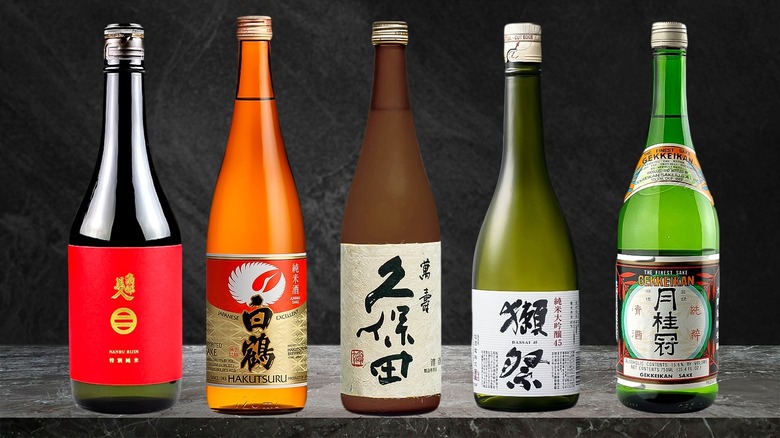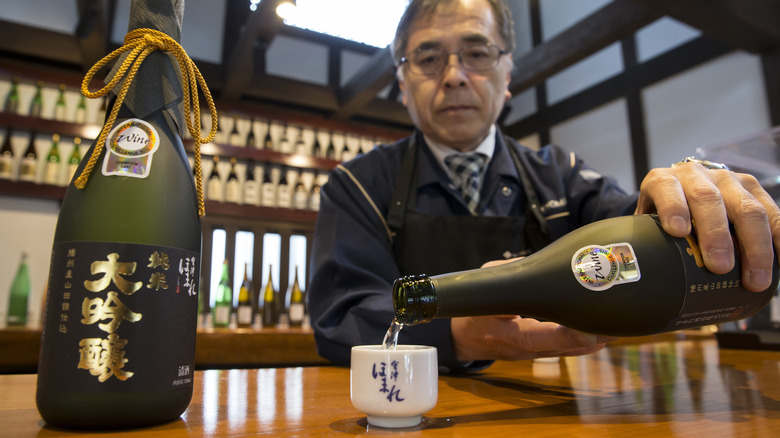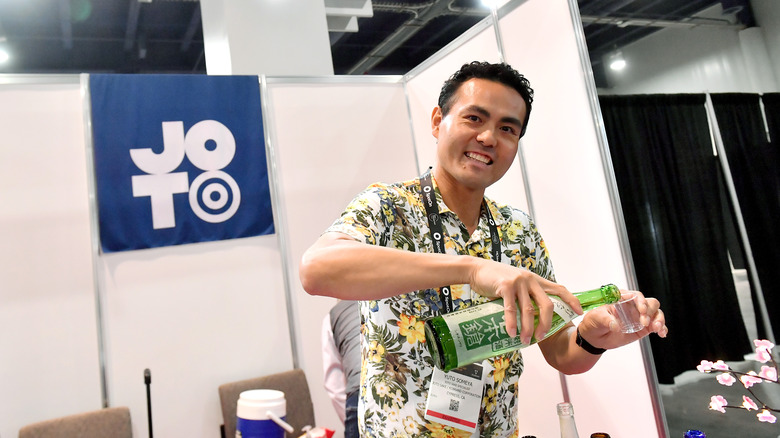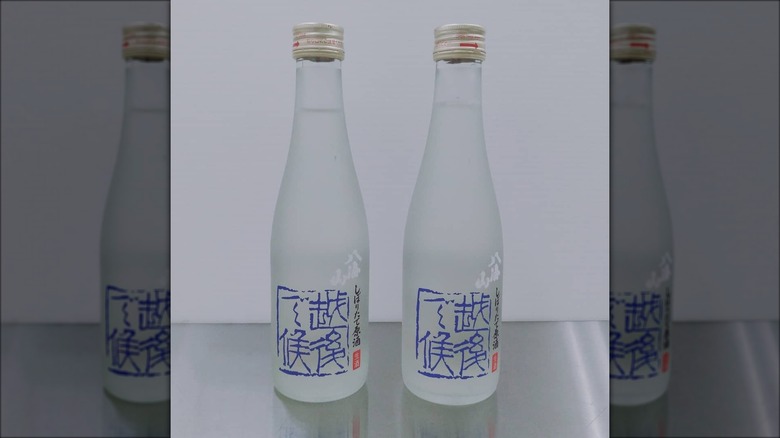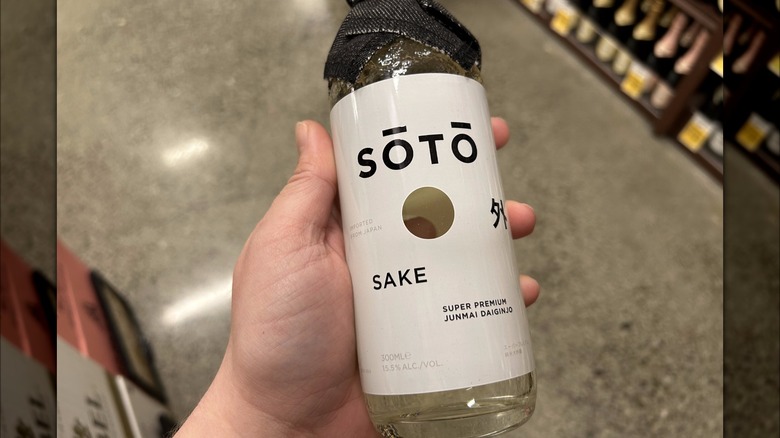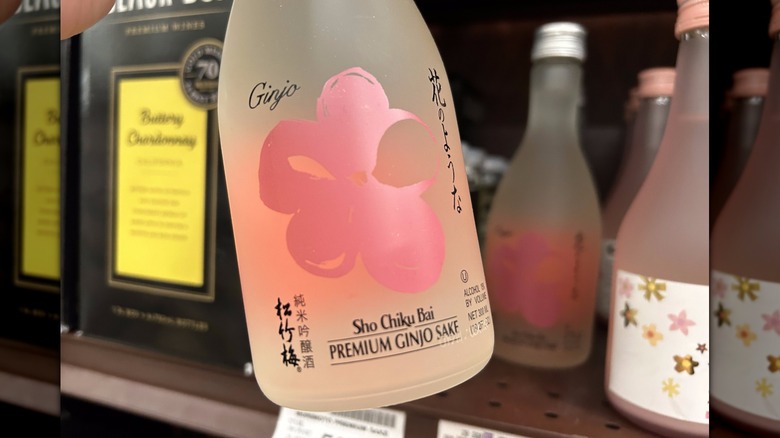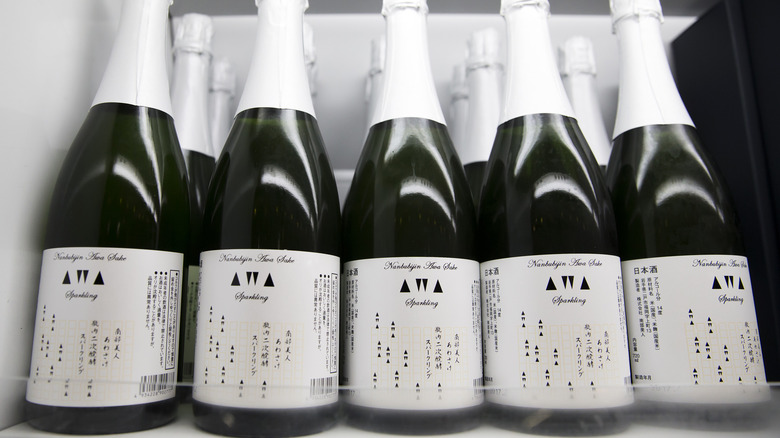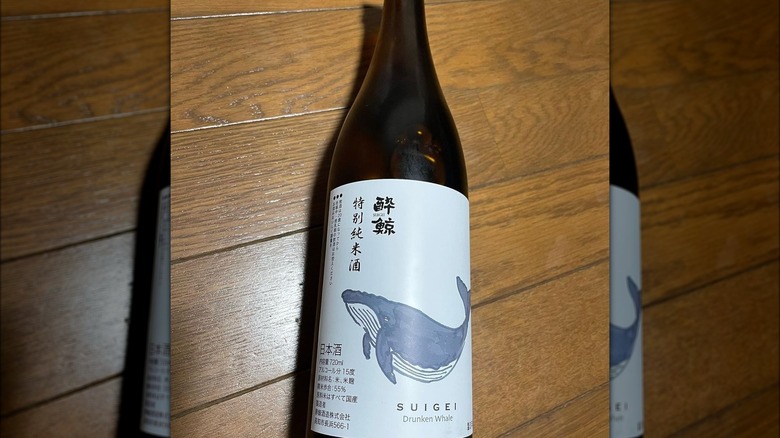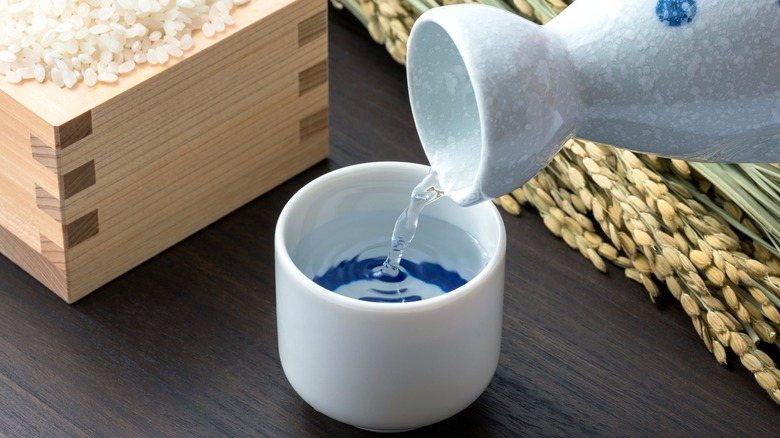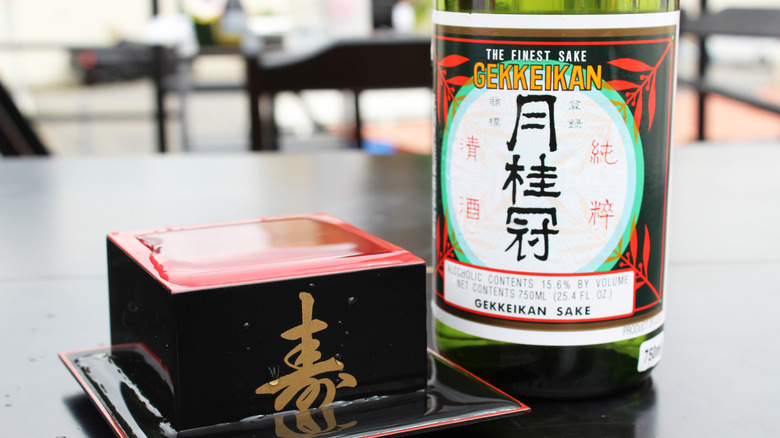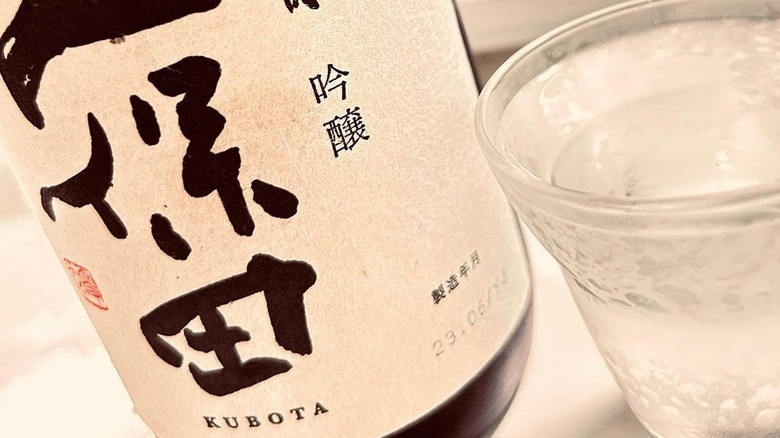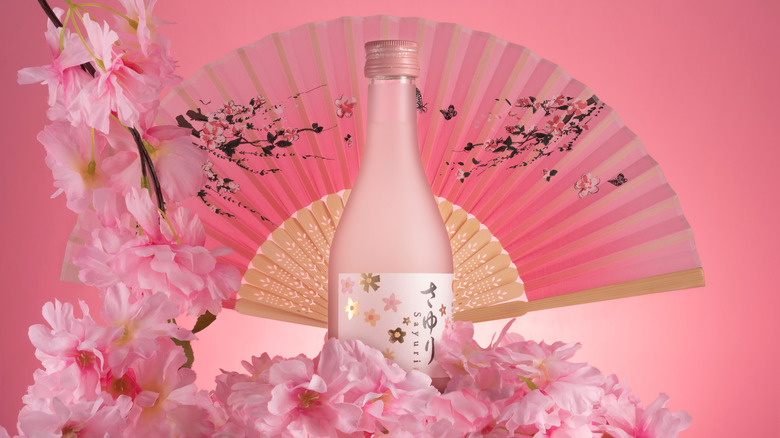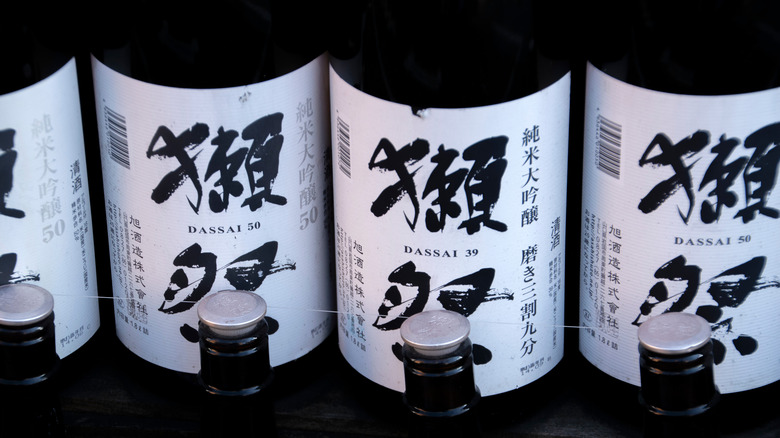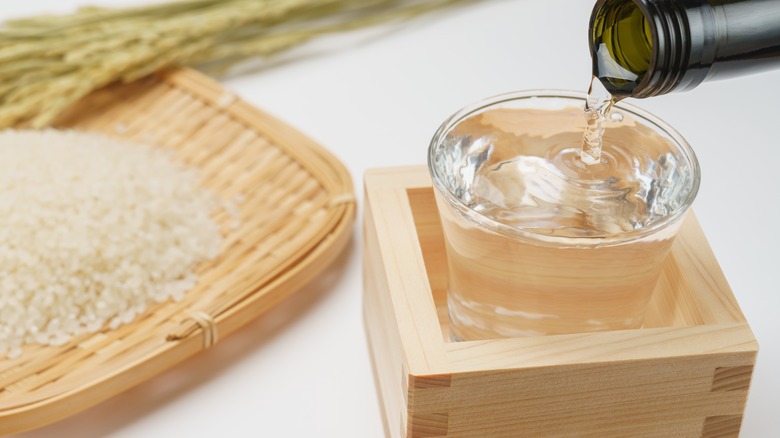12 Top-Rated Sake Brands, Ranked
Sake is a delicious alcoholic beverage from Japan, boasting an umami-forward quality that has earned a place among the world's most famous fermented refreshments, especially in recent decades. Traditionally, sake is made using only four ingredients: water, rice, yeast, and a rice mold called koji. Although sake is commonly called rice wine in English-speaking demographics, sake is not actually a wine so much as its own alcoholic category.
In a similar sentiment shared with all alcoholic beverages, including wine, craft beer, and whisky, sake requires its admirers to take on a bit of a learning curve before casual interest can bloom into connoisseur-level sake appreciation. And when it comes to choosing the right type, taste, and, of course, beverage brand, sake is as intimidating as it is tasty.
For those who are new to the world of sake sipping, confidently selecting one bottle of sake off a shelf stocked with numerous options ... well, it'd be better to read up on this Japanese drink and its brands before the stress of buying an unfamiliar beverage sets in. Instead of letting panic kick in, take the time to study the difference between clear and cloudy sake, chilled and hot, and all the fascinating whatnot in between. Take those first steps toward becoming an aficionado of all things sake starting here, with this breakdown of popular sake brands, ranked by combining principles of popularity, personal preference, and an objective cost-to-quality ratio as well. For more on our methodology, read 'till the end.
12. Aizu Homare
For a sake brand so authentically Japanese that it doesn't even have a website for non-Japanese readers, look no further than Aizu Homare — the name can be translated in English to mean either "honor" or "glory." The Aizu Homare sake brewery is located at the base of Kitakata city's Mount Iide. This establishment was first opened in 1918 by Kosaku Karahashi, who originally sold rice at wholesale and manufactured miso and koji before switching lanes to make exemplary, traditional sake. The career change was a good call, as indicated by the cascade of awards Aizu Homare has taken home.
The sake produced at Aizu Homare's brewery is available in both traditional and more fruit-forward flavors — another way to drink sake. Although strawberry and yuzu sake may not seem as authentic as clear and cloudy sake, Aizu Homare ensures even its fruity flavors pay the same honor to the craft as those without. Aizu Homare sake can cost around $12 to $60, depending on which product you choose.
11. Joto
Joto, meaning "highest quality" in English, is a true-to-its-name sake brand. Uniquely, it was founded in 2005 by Henry Sidel, an American man who studied Japanese in a Minnesota college before living in Japan as a homestay student. He then went on to work his way up in the food and beverage industry and was introduced to sake in 1999. Sidel's love for sake drove him to start his own sake company with three breweries, all of which were distributed only to New York. Now, Joto brand sake can be found on almost any shelf alongside the other big-name sake brands.
The quality and quick surge in popularity of Joto sake is because of the company's careful selection and curation of Japan-based sake breweries. Currently, Joto imports from 10 family-owned Japanese breweries with a collective of 71 generations of sake-brewing expertise between them: Eiko Fuji Brewery, Hakuto Brewery, Huchu Homare Brewery, Izumo Fuji Brewery, Kameizumi Brewery, Marumoto Brewery, Nakao Brewery, Saiya Brewery, Tajima Brewery, and Tomita Brewery.
10. Hakkaisan
Hakkaisan sake is a testament to the symbiotic relationship between man and mountain, snowmelt and sake, and all the care and consideration that goes into creating a balanced and authentic sake-sipping experience. This sake brewery is located at the base of Mount Hakkai, a region famous for its snowfall, which can reach more than 10 feet high. As the snow of Mount Hakkai melts each year, Hakkaisan brand sake is able to utilize the local water source, as well as its house-made koji rice, to make its signature style of sake.
The sake at Hakkaisan is produced to pair well with food — so long as you don't pour your own sake since this is considered rude in Japanese culture — and can be consumed chilled or warm based on your desire. The brewing process is done in-house in small batches with consideration toward temperature and timing. Hakkaisan describes their sake as "a well-balanced clean and dry sake style called tanrei karakuchi, featuring a smooth texture, an elegant umami flavor, and a crisp finish."
Hakkaisan sake can sell for anywhere from about $28 to nearly $80 per bottle, with the price varying depending on the style of sake as well as its rarity and popularity.
9. Sōtō
Sōtō sake, launched in 2015 by two North Americans and brewed in Niigata, Japan, is recognizable for its signature modern, minimalistic black and white bottling and labeling, which accurately reflects the simple, elegant, and impactful nature of this award-winning sake. Though Sōtō has a modern appearance, its sake-making practices are every bit a traditional celebration of a culturally significant Japanese craft. For instance, it makes its beverages using only four ingredients: rice, koji, water, and yeast. Though, there is a "secret fifth ingredient" listed on Sōtō's website: snowmelt.
The product is advertised as being all-natural: gluten-free and vegan with no added sugars, preservatives, or sulfites. In English, Sōtō translates to "outside," which suits the brand's nature-driven approach toward the art of sake sourcing, crafting, and sipping.
Sōtō products include the Junmai Daiginjo, Junmai, and other limited edition sakes as well. Sōtō sakes are sold both individually and in bundles.
8. Sho Chiku Bai
Sho Chiku Bai is a sake brand based out of Berkeley, California, but its origins and products are as authentically Japanese as can be. You see, Sho Chiku Bai sake brand is a branch of Takara Sake, an operation that opened its doors in Japan over 180 years ago in 1842. Takara Sake USA Inc. was established in 1983 and has since manufactured and distributed its products to a more global sake-sipping audience, especially with the popular Sho Chiku Bai brand.
Takara's Sho Chiku Bai sake brand uses resources local to its location in coastal central California, which allows for authentic Japanese methods of making sake from ingredients found in the surrounding area with a sense of consideration and respect for nature. In this case, the sake-making process includes sourcing fresh snowmelt from the surrounding Sierra Nevada mountains as well as rice grown in the rich soil of the Sacramento Valley. The price range of Sho Chiku Bai sake is incredibly variable due to its large range of products, sizes, and qualities available.
7. Nanbu Bijin
Nanbu Bijin, based in Ninohe city, is a sake company with 120 years' worth of experience in crafting delicious drinks. Before the founder of Nanbu Bijin turned his attention to alcoholic beverage production, the family's business was actually in the soy sauce industry. And though the shift from soy sauce to sake may seem significant, considering that they are very different types of fermented food products, after all, Nanbu Bijin's sake-making methodology was originally based on the founder's family knowledge of soy sauce brewing. This origin story makes Nanbu Bijin's sake truly special and wholly unique.
After surviving significant historical shifts and cultural circumstances that challenged the company to change and adapt rapidly, those behind Nanbu Bijin and its beverages never lost sight of the high standard of quality expected from each batch of sake. This dedication and perseverance not only got the company through over a century of business but also won Nanbu Bijin and its beverages multiple awards as well.
6. Suigei
If you've ever seen a tipsy-looking whale or a jaunty illustration of a whale tail on a bottle of sake, you have probably already been exposed to Suigei sake. Founded in 1872, Suigei Brewery boasts the title of being the only sake brewery in all of Kochi city. Though the company forwent its original name during its 150-plus years of sake-making, its dedication to traditional, tasty beverage brewing has remained unchanged. The company's name, Suigei, translates to "drunk whale." This name was an amusing nod to a Japanese alcohol-loving feudal lord who, as the story tells it, called himself "Geikai Suiko" — a drunkard lord in a sea full of whales.
Suigei sake is best enjoyed with food, which the makers suggest will better match the umami-rich and rather dry bite of the company's traditional brew. The most affordable bottle of sake you can buy from Suigei is the Tokubetsu Junmai for roughly $27, while the most expensive sake Suigei currently offers is the Mann Junmai Daiginjo with a price tag of around $188.
5. Yamatogawa
Yamatogawa is a celebrated sake-brewing company located in Kitakata, a city famous for its fantastic ramen as well as its sake, a beverage that goes well with savory noodles. This historical sake brewery was established in Japan's Edo Era over 230 years ago, placing the grand opening of Yamatogawa in the year 1790. In other words, Yamatogawa serves up some seriously tradition-steeped styles of sake and does so without falling behind in terms of the technological advancements that the past two-plus centuries have made available.
According to Yamatogawa, the rich agricultural and cultural environment of Kitakata is largely responsible for shaping the sake the company produces. Apart from the region's inherent qualities, the brand's dedication to sourcing the best rice — grown in-house on the Yamatogawa Farm — from the best soil and treating it with the best, most traditional methods is also a big part of what makes Yamatogawa brand sake so delicious.
4. Gekkeikan
Gekkeikan is a 386-year-old sake brand that began brewing alcoholic beverages in 1637 in what is now known as Kyoto's Fushimi Ward in Japan. Its nearly four centuries of sake crafting comes with a rich history — the Gekkeikan brand name was registered as an official trademark in 1905, but the company was renamed short of 40 years later, only to return to the Gekkeikan name for its 350th anniversary. Afterward, it expanded its foothold to California, U.S. and Shanghai, China. Given Gekkeikan's historical and cultural contribution to the Japanese sake culture and industry, the Gekkeikan Okura Sake Museum was subsequently established in the brand's birthplace, Fushimi Ward.
Today, Gekkeikan sake is still prepared traditionally and without the addition of preservatives or sulfites. The brand offers a wide range of sake options, each of which is accompanied by an online page outlining its ingredients, flavor profile and notes, the best food pairings for the sake, the best temperature to serve the sake at, and much, much more. Gekkeikan sake is also very affordable, with prices in the $7 range for a large bottle.
3. Kubota
Kubota is a 193-year-old sake company located in one of Japan's most notable cities for growing high-quality rice, Niigata. The Kubota philosophy of sake production is intrinsically tied to the seasonality of the surrounding natural landscape and its vital resources. The company also cites its people involved in the sake production pipeline play a huge role in the quality of the brand's beverages. Notably, Kubota takes pride in its products pairing perfectly with a wide range of plates, even including chocolate desserts, which is quite unique for pairing suggestions between food and sake.
Kubota offers over 10 types of regular sake as well as a rotation of seasonal bottles. The least expensive of these can cost just under $30, while the higher end ranges between $40 and $70. Kubota's most expensive sakes tend to come from the limited stock of seasonal sakes, which can easily sell for over $160.
2. Hakutsuru
Hakutsuru Sake Brewery, based in Nada, Japan, is a historic company with about 280 years of sake-making experience to its brand name. Since the year 1743, people have enjoyed sipping on Hakutsuru's delicious sakes. The inspiration for the name Hakutsuru came from the elegance of the white crane, a symbolic animal that carries an auspicious cultural significance in Japan.
Hakutsuru prides itself in historically significant moments such as its first glass bottle sale, which took place in 1878, according to the Hakutsuru timeline, and the subsequent exhibition of said bottled sake at the World's Fair in Paris in 1900. Having survived the historical implications of both world wars, as well as earthquakes and other obstacles, Hakutsuru hit the U.S. market in 2005 and now sells its sake to 55 regions and countries across the globe. Hakutsuru sake is made using locally sourced rice and fresh spring water from the Rokkō Mountains, which the company cites as responsible for the flavorful mineral qualities of Hakutsuru sake.
1. Dassai
Dassai is a famous brand of sake made by Asahi Shuzo based in Japan's Yamaguchi Prefecture. In English, Dassai translates to "otter festival," a nod to the regional river otters that once populated the surrounding landscape. Dassai brand sake is intended to toe the line between small-batch quality and wide-reach accessibility, and, though not meant for mass consumption, Asahi Shuzo continues to find creative ways to keep Dassai on the market with startling reliability.
Though the roots of Dassai and Asahi Shuzo are as traditional as can be, the company values keeping up with contemporary practices and advancements more than staying true to the constraints of traditional sake-making. As a result, Dassai is confident it will continue to pave the way in revolutionizing the authentic taste of sake. Alongside the usual sakes you expect from a sake brewery, Dassai also sells seasonal sakes, sparkling sakes, and what the website describes as avant-garde sakes.
This brand of sake sells on the less expensive end of the spectrum for as low as $20 per bottle, with many more of its beverages hovering between $40 to $80. Bottles of the most expensive Dassai sakes, however, can cost up to and over $500 each.
Methodology
The methodology behind ranking these sakes was developed by factoring in research, demand, personal preference, and an objective cost-to-quality ratio comparison. We assessed the sake brands most often available on marketplace shelves and compared them with at-home research across brand websites and consumer reviews. We also crowdsourced favorites from sake-loving friends, family, and the author's own sake-drinking experience. These findings were then cross-examined and checked against the menus of some phenomenal Japanese restaurants with extensive sake menus to ensure the top 12 ranking was fair and comprehensive.
